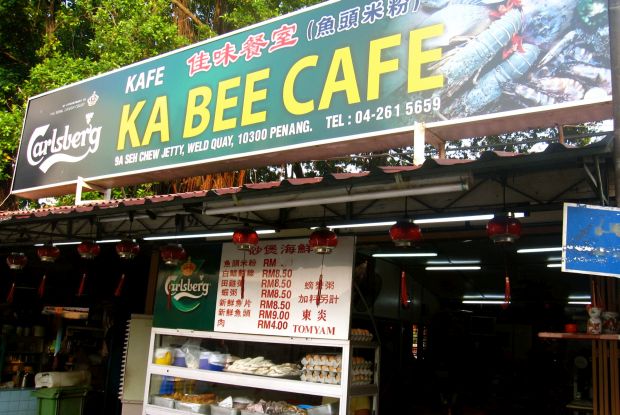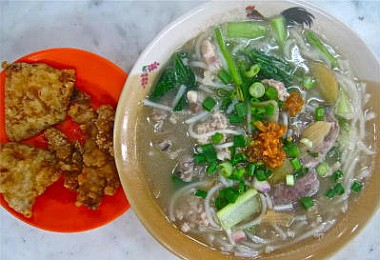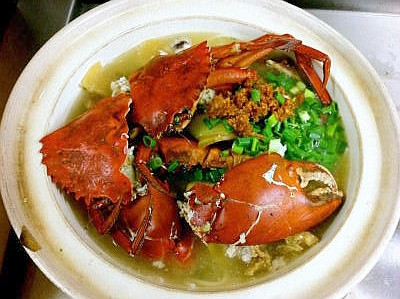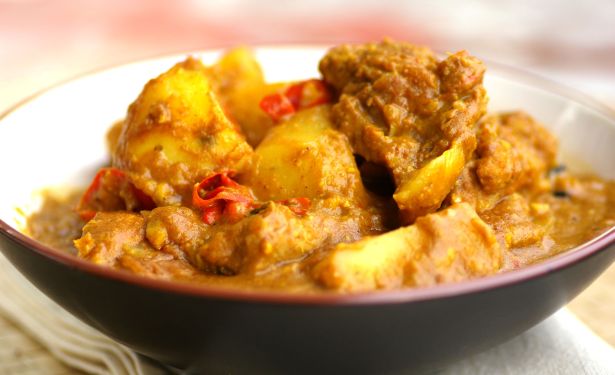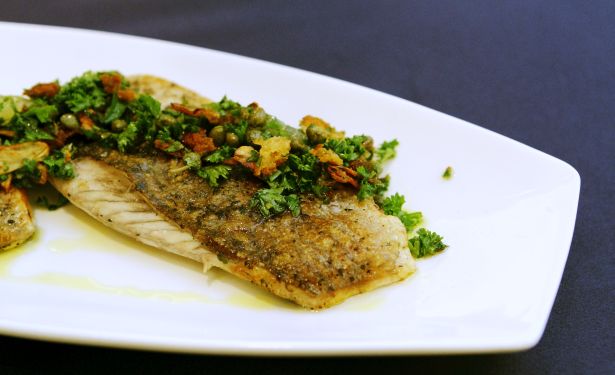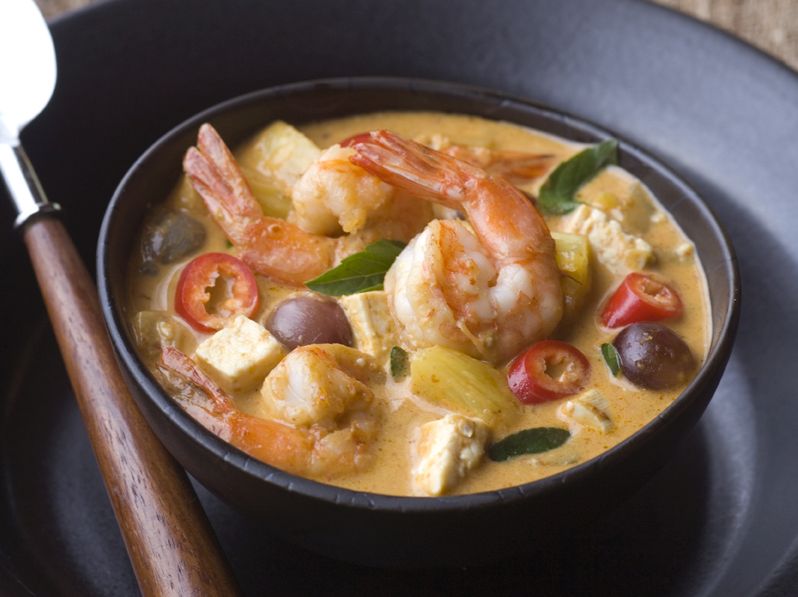Ka Bee Cafe,
9A Seh Chiew Jetty,
Weld Quay,
George Town, Penang.
Open daily except Sundays,
11.00am-2.30pm; 5pm-10.30pm.
To be on Chew’s SMS alert list, call 04-261 5659.
The proprietor of Ka Bee Cafe is obsessed with size.
KA Bee Cafe is a coffeeshop – a very popular one despite having only one stall for the past two decades.
Its signature street fare ranges from below RM10 to, well, hundreds of ringgit (for a group serving, of course).
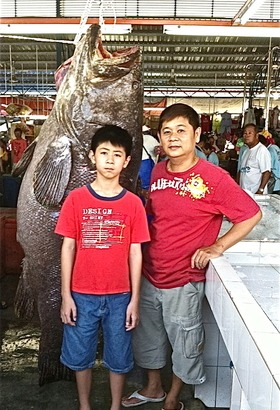 The one that didn’t get away: Kar Be Cafe operator Chew Kean Ghee and his son with the whopper they bought from the market.
The one that didn’t get away: Kar Be Cafe operator Chew Kean Ghee and his son with the whopper they bought from the market.
Famed for its crab broth, lobster bee hoon, tau tey (large white pomfret) bee hoon and fish head bee hoon, the coffeeshop along the busy waterfront of Weld Quay, Penang, is always packed – especially at dinner time.
Despite the limited parking space most of the time (locals usually park across the road in the back alleys and walk), the coffeeshop, which marks the entrance to the historic Chew Jetty clanhouses, is one of the most popular seafood noodle and broth stalls on the island.
The strong whiff of thinly sliced ginger tantalises the senses way before a bowl even reaches the table.
Sprinkled with fresh spring onions and generous helpings of fish balls, minced pork and of course, an array of seafood, a bowl of noodles here is a hearty treat indeed.
And even if you are not feeling particularly hungry, a side order of deep-fried fish fillet and mantis prawn dipped in chilli sauce is a must.
When the shop first opened for business, a bowl of noodles was RM3.50.
Now it’s RM6 – still a relatively modest indulgence, considering inflation and the increase in the cost of ingredients.
Like similar eateries, the prices of the “specials” depend on the weight of the seafood picked. For example, a giant crab could cost up to RM75 per kilo while lobsters can go up to RM200.
There are 10 to 15 seafood varieties, including choice oysters, chui kei (paddy frogs), freshwater eels (if you are lucky) and squids.
Ka Bee Cafe operator Chew Kean Ghee maintains that he doesn’t make much profit from these extras but has to serve them so that customers have more options.
Chew is a regular face in George Town’s markets and is especially popular among the fishmongers. The friendly 40-year-old with the megawatt grin scours the wet markets of Cecil Street and Jelutong – just to name a few, twice a day, come rain or shine.
“I have to make sure the seafood I serve is fresh – the only way to do that is if I go to the market myself,” he says.
He is always on the lookout for exotic seafood but is mainly drawn to anything big.
Yes, size does matter to Chew, and every time a fisherman nets a whopper, his is the first number they call.
“They know I’m obsessed with size – the bigger the fish, crab, lobster or whatever, the better.
“Initially, I wasn’t sure my customers were willing to pay but I figured that if they weren’t, I could always enjoy it with the family so no wastage there,” he says.
Ironically, despite his “fishy fascination”, Chew laments that he can’t bear to get on a boat and go fishing because he gets terribly seasick.
“I would love to serve my own catch but unfortunately, unlike my fisherman father, I don’t have sea legs and can’t stand to be in a boat,” he says.
Chew became an unwitting celebrity after making headlines when he forked out close to RM10,000 for a fish!
The most recent media coverage was when he carted home a whopping grouper, or loong tan to the Chinese, from the Cecil Street market for more than RM8,500 a few months back.
The fish, caught off Teluk Bahang, weighed 165kg and was about 2m long.
It took six men at the market to hang up the giant fish and remove its scales. According to Chew, it probably takes some 30 years for a grouper to grow to that size.
The fish, among the biggest caught in Malaysian waters, was used to make more than 300 bowls of noodles.
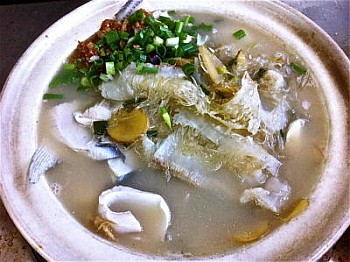 Extra deep-fried fish and mantis prawns are popular side orders; a tempting bowl of fish head bee hoon.
Extra deep-fried fish and mantis prawns are popular side orders; a tempting bowl of fish head bee hoon.
“The most I’ve paid for a whopper was about RM9,000.
“Bigger groupers nourish the joints and taste better because the flesh is sweeter and the chewy texture of the skin is something you have to taste to understand why my regulars are willing to travel here from as far away as Kedah, KL and Singapore for a bowl.
“I’ll send an SMS alert whenever I stumble upon something special,” he says, while preparing a bowl for me.
Chew himself can’t get enough of giant loong tan and confesses to cooking “the most expensive ingredients” for himself at least three times a week.
Worth every sen
Chew’s customers share his love for the “biggies” which he started buying a decade ago.
Back then, he wasn’t sure how to cut or clean a fish larger than an adult human being but he knew he had to have it.
The plumber-turned-cook has since mastered the skills required.
“You are lucky I bought a relatively big loong tan a few days ago.
“I can’t explain why people are willing to pay RM50, RM150 or more for a coffeeshop meal but you will understand after having it for yourself,” he says confidently.
True enough, Chew’s claim was not a mere boast.
The sweetness of the fish added considerable flavour to the bak kut (pork bone) soup stock and the fish skin was like nothing I’d sampled before – its texture similar to the urat (tendon) that make the sup kambing a Malaysian supper favourite, but way more tender and succulent. Chew’s special bak kut stock is left to boil for at least 12 hours.
Previously, he cooked over a charcoal fire but now, as with most successful hawkers, he uses gas.
The chicken bones he used in the early days have since been replaced by the pricier and much tastier bak kut.
Chicken bones went out the coffeeshop window because he wanted to cater to customers who had undergone operations and were not allowed to consume poultry as it’s believed to hamper the healing process.
“On average, I boil six large pots of stock daily but during busy periods such as school holidays, I make about 11 pots – every drop is either sold or thrown away because it’s important for the soup stock to be clear, not murky.
He says adding different seafood to the stock adds a different dimension to the flavour.
He gets lots of foreign customers, from as near as Indonesia to as far away as the United States.
“They give me the thumbs-up, and that’s the best compliment ever,” he beams.
Chew’s method of preparing the dish is to cook the seafood requested by customers in the bak kut stock for about three minutes before serving it piping hot.
Although he has a staff of six to help, no one mans the stoves except Chew and his wife Ang Mei Hua, 39.
“I’ve been helping him since day one but the regulars still want him to handle their orders.
“Since he started buying these enormous fishes, our business has boomed. I guess we are the only seafood shop that serves giant fish around here so we have a loyal following,” Ang muses.
Beeping all fans
Ka Bee was filled with colourful feathers before Chew’s brother turned their grandfather’s bird shop into a kopitiam some 20 years ago.
His brother is now working in a restaurant in London.
“My sister and our other brother used to help out at the shop.
“She now has a stall just like mine nearby while our other brother is in Ireland.
“All the Chew siblings are in the food business although none of them share my love for huge, exotic seafood,” he says proudly.
Chew loves to entertain and sometimes after the “official business” is done, he prepares some seafood dishes for friends.
“I just really like to cook and most of it, I learnt myself,” he laughs.
“On some days when I manage to get a big fish in, we stop taking orders at 8.30pm because we don’t want customers to wait for too long so we tell them upfront that it’s a long queue.
“Usually, our regulars swarm the place once my SMS alert goes out.
“I never give preferential treatment to ‘big shots’ but I’ve been told off many times by impatient customers, and the elderly, especially, who want me to keep an eye out to make sure no one gets ahead of them, and they aren’t afraid to remind me who came first,” he says laughing.
Chew has had requests to open a branch in Kuala Lumpur but he says logistics and quality control are issues to consider.
“But we will see,” he says.
